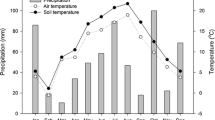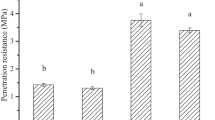Abstract
Background and aims
The significance of biopores for nutrient acquisition from the subsoil depends on root-soil contact, which in turn is influenced by root architecture. The aim of this study was to detect differences regarding the architecture and root-soil contact of homorhizous barley roots (Hordeum vulgare L.) and allorhizous oilseed rape roots (Brassica napus L.) growing in biopores.
Methods
In situ endoscopy was used as a technique that allows non-destructive display of pore wall characteristics and root morphology inside large biopores under field conditions.
Results
For both crops, about 85 % of all roots did establish contact to the pore wall. However, according to their different root architecture, the two crops varied in their strategy of resource acquisition: While barley was characterized by thin vertical or ingrowing roots, most of them in direct contact to the pore wall, oilseed rape established contact to the pore wall predominantly via lateral roots.
Conclusions
Root morphological and pore wall assessment with in situ endoscopy in combination with detailed studies of soil biochemical and soil physical parameters of the pore wall is considered an essential prerequisite for more precise future modelling of nutrient acquisition and uptake.








Similar content being viewed by others
References
Alakukku L, Nuutinen V, Ketoja E, Koivusalo H, Paasonen-Kivekäs M (2010) Soil macroporosity in relation to subsurface drain location on a sloping clay field in humid climatic conditions. Soil Till Res 106:275–284
Arredondo JT, Johnson DA (1999) Root architecture and biomass allocation of three range grasses in response to non uniform supply of nutrients and shoot defoliation. New Phytol 143:373–385
Athmann M, Kautz T, Köpke U (2012) Einsatz angepasster Endoskopie zur Charakterisierung des Wurzelwachstums in Bioporen. In: Merbach W, Ruppel S, Augustin J (eds) Mitteilungen Agrarwissenschaften Bd. 20, 22. Borkheider Seminar zur Ökophysiologie des Wurzelraums, Verlag Dr. Köster, Berlin, pp 13–19
Bengough AG (2003) Root growth and function in relation to soil structure, composition and strength. In: De Kroon H, Visser EJW (eds) Root ecology. Springer, Berlin, pp 151–171
Bengough AG, Bransby MF, Hans J, McKenna SJ, Robert TJ, Valentine TA (2006) Root responses to soil physical conditions; growth dynamics from field to cell. J Exp Bot 57:437–447
Bibikova T, Gilroy S (2003) Root hair development. J Plant Growth Regul 21:383–415
Bingham IJ, Bengough AG (2003) Morphological plasticity of wheat and barley roots in response to spatial variation in soil strength. Plant Soil 250:273–282
Bouché MB (1975) Action de la faune sur les etats de la matiere organique dans les ecosystemes. In: Kilbertius G, Reisinger O, Mourey A, da Fonseca JAC (eds) Humification et biodegradation. Pierron, Sarreguemines, pp 157–168
Casimiro I, Beeckman T, Graham N, Bhalerao R, Zhang H, Casero P, Sandberg G, Bennett MJ (2003) Dissecting Arabidopsis lateral root development. Trends Plant Sci 8:165–171
Cresswell HP, Kirkegaard JA (1995) Subsoil amelioration by plant roots—the process and the evidence. Aust J Soil Res 33:221–239
Devliegher W, Verstraete W (1997) Microorganisms and physico-chemical conditions in the drilosphere of Lumbricus terrestris. Soil Biol Biochem 29:1721–1729
Dexter AR (1986) Model experiments on the behaviour of roots at the interface between a tilled seed-bed and a compacted sub-soil. I. Effects of seed-bed aggregate size and sub-soil strength on wheat roots. Plant Soil 95:123–133
Edwards CA, Lofty JR (1980) Effects of earthworm inoculation upon the root growth of direct drilled cereals. J Appl Ecol 17:533–543
Ehlers W (1975) Observations on earthworm channels and infiltration on tilled and untilled loess soil. Soil Sci 119:242–249
Ehlers W, Köpke U, Hesse F, Böhm W (1983) Penetration resistance and root growth of oats in tilled and untilled loess soil. Soil Till Res 3:261–275
Ewens M, Leigh RA (1985) The effect of nutrient solution composition on the length of root hairs of wheat (Triticum aestivum L.). J Exp Bot 36:713–724
Gahoonia TS, Nielsen NE (2004) Barley genotypes with long root hairs sustain high grain yields in low-P field. Plant Soil 262:55–62
Gaiser T, Perkons U, Küpper PM, Puschmann DU, Peth S, Kautz T, Pfeifer J, Ewert F, Horn R, Köpke U (2012) Evidence of improved water uptake from subsoil by spring wheat following lucerne in a temperate humid climate. Field Crops Res 126:56–62
Görres JH, Savin MC, Amador JA (2001) Soil macropore structure and carbon mineralization in burrows and casts of an anecic earthworm (Lumbricus terrestris). Soil Biol Biochem 22:1881–1887
Graff O (1967) Über die Verlagerung von Nährelementen in den Unterboden durch Regenwurmtätigkeit. Landwirt Forsch 20:117–127
Hammac W, Pan W, Bolton R, Koenig R (2011) High resolution imaging to assess oilseed species’ root hair responses to soil water stress. Plant Soil 339:125–135
Hirth JR, McKenzie BM, Tisdall JM (2005) Ability of seedling roots of Lolium perenne L. to penetrate soil from artificial biopores is modified by soil bulk density, biopore angle and biopore relief. Plant Soil 272:327–336
Jégou D, Schrader S, Diestel H, Cluzeau D (2001) Morphological, physical and biochemical characteristics of burrow walls formed by earthworms. Appl Soil Ecol 17(2):165–174
Jungk A (2001) Root hairs and the acquisition of plant nutrients from soil. J Plant Nutr Soil Sci 164:121–129
Kautz T, Köpke U (2010) In situ endoscopy: new insights to root growth in biopores. Plant Biosystems 144(2):440–442
Kautz T, Landgraf D, Köpke U (2011) Biomass and abundance of the anecic earthworm Lumbricus terrestris L. under perennial fodder crops. Proceedings of the 3rd Scientific Conference of ISOFAR 28 September–1 October 2011 Gyeonggi Paldang, Republic of Korea
Kautz T, Amelung W, Ewert F, Gaiser T, Horn R, Jahn R, Javaux M, Kemna A, Kuzyakov Y, Munch JC, Pätzold S, Peth S, Scherer HW, Schloter M, Schneider H, Vanderborght J, Vetterlein D, Walter A, Wiesenberg GLB, Köpke U (2013) Nutrient acquisition from arable subsoils in temperate climates: a review. Soil Biol Biochem 57:1003–1022
Lavelle P, Melendez G, Pashanasi B, Schaefer R (1992) Nitrogen mineralization and reorganization in casts of the geophagous tropical earthworm Pontoscolex corethrurus (Glossoscolecidae). Biol Fertil Soils 14:49–53
Mackay AD, Barber SA (1985) Effect of soil moisture and phosphate level on root hair growth of corn roots. Plant Soil 86:321–331
McKenzie BM, Bengough AG, Hallett PD, Thomas WTB, Forster B, McNicol JW (2009) Deep rooting and drought screening of cereal crops: a novel field-based method and its application. Field Crops Res 112:165–171
Michael G (2001) The control of root hair formation: suggested mechanisms. J Plant Nutr Soil Sci 164:111–119
Pagenkemper SK, Peth S, Uteau D, Horn R (2013) Effects of root-induced biopore architectures on physical processes investigated with industrial X-ray computed tomography. In: Anderson SH, Hopmans JW (Eds) Tomography and imaging of soil-water-root processes 2nd ed. SSSA Special Publication. In press
Pankhurst CE, Pierret A, Hawke BG, Kirby JM (2002) Microbiological and chemical properties of soil associated with macropores at different depths in a red-duplex soil in NSW Australia. Plant Soil 238:11–20
Parkin TB, Berry EC (1999) Microbial nitrogen transformations in earthworm burrows. Soil Biol Biochem 31:1765–1771
Passioura JB (2002) Soil conditions and plant growth. Plant Cell Environ 25:311–318
Pitkänen J, Nuutinen V (1997) Distribution and abundance of burrows formed by Lumbricus terrestris L. and Aporrectodea caliginosa Sav. in the soil profile. Soil Biol Biochem 29:463–467
Rose TJ, Rengel Z, Ma Q, Bowden JW (2009) Crop species differ in root plasticity response to localised P supply. J Plant Nutr Soil Sci 172:360–368
Smith S, De Smet I (2012) Root system architecture: insights from Arabidopsis and cereal crops. Philos Trans R Soc B: Biol Sci 367:1441–1452
Smucker AJM (1993) Soil environmental modifications of root dynamics and measurement. Annu Rev Phytopathol 31:191–218
Stewart JB, Moran CJ, Wood JT (1999) Macropore sheath: quantification of plant root and soil macropore association. Plant Soil 211:59–67
Stirzaker RJ, Passioura JB, Wilms Y (1996) Soil structure and plant growth: impact of bulk density and biopores. Plant Soil 185:151–162
Tiunov AV, Scheu S (1999) Microbial respiration, biomass, biovolume and nutrient status in burrow walls of Lumbricus terrestris L. (Lumbricidae). Soil Biol Biochem 31:2039–2048
Tracy SR, Black CR, Roberts JA, Sturrock C, Mairhofer S, Craigon J, Mooney SJ (2012) Quantifying the impact of soil compaction on root system architecture in tomato (Solanum lycopersicum) by X-ray micro-computed tomography. Ann Bot 110:511–519
Watt M, Magee LJ, McCully ME (2008) Types, structure and potential for axial water flow in the deepest roots of fieldgrown cereals. New Phytol 178:135–146
White RG, Kirkegaard JA (2010) The distribution and abundance of wheat roots in a dense, structured subsoil—implications for water uptake. Plant Cell Environ 33:133–148
Wu F, Wan JHC, Wu S, Wong M (2012) Effects of earthworms and plant growth—promoting rhizobacteria (PGPR) on availability of nitrogen, phosphorus, and potassium in soil. J Plant Nutr Soil Sci 175(3):423–433
Zhang YJ, Lynch JP, Brown KM (2003) Ethylene and phosphorus availability have interacting yet distinct effects on root hair development. J Exp Bot 54:2351–2361
Acknowledgements
This study was supported by the German Research Foundation (Deutsche Forschungsgemeinschaft—DFG) within the framework of the research unit DFG FOR 1320. Details of the field trials potentially open for external researchers: www.for1320.uni-bonn.de.
Author information
Authors and Affiliations
Corresponding author
Additional information
Responsible Editor: David James Chittleborough.
Rights and permissions
About this article
Cite this article
Athmann, M., Kautz, T., Pude, R. et al. Root growth in biopores—evaluation with in situ endoscopy. Plant Soil 371, 179–190 (2013). https://doi.org/10.1007/s11104-013-1673-5
Received:
Accepted:
Published:
Issue Date:
DOI: https://doi.org/10.1007/s11104-013-1673-5




